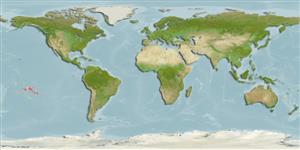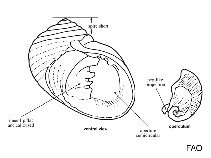Nerita morio (Sowerby, 1833)
| Native range | All suitable habitat | Point map | Year 2050 |

|
| This map was computer-generated and has not yet been reviewed. |
| Nerita morio AquaMaps Data sources: GBIF OBIS |
Google image | No image available for this species;
drawing shows typical species in Neritidae.
Classification / Names Common names | Synonyms | CoL | ITIS | WoRMS
Gastropoda | Cycloneritida | Neritidae
Environment: milieu / climate zone / depth range / distribution range Ecology
Benthic. Tropical
Distribution Countries | FAO areas | Ecosystems | Occurrences | Introductions
Eastern Pacific: Form Easter Island and Sala y Gómez westward in a narrow band through the Pitcairn Islands and Rapa to the Gambier and Austral Islands.
Length at first maturity / Size / Weight / Age
Maturity: Lm ? range ? - ? cm Max length : 1.9 cm SHW male/unsexed; (Ref. 87884)
Life cycle and mating behavior Maturity | Reproduction | Spawning | Eggs | Fecundity | Larvae
Main reference
References | Coordinator | Collaborators
Spencer, H.G., J.M. Waters and T.E. Eichhorst 2007 Taxonomy and nomenclature of black nerites (Gastropoda: Neritimorpha: Nerita) from the South Pacific. Invertebrate Systematics 21(3):22. (Ref. 88768)
IUCN Red List Status
(Ref. 130435: Version 2025-1)
CITES status (Ref. 108899)
CMS (Ref. 116361)
Threat to humans
Human uses
| FishSource |
Tools
More information
Diet composition
Food consumption
Predators
Max. ages / sizes
Length-weight rel.
Length-length rel.
Length-frequencies
Mass conversion
Abundance
Internet sources
BHL | BOLD Systems | CISTI | DiscoverLife | FAO(Publication : search) | Fishipedia | GenBank (genome, nucleotide) | GloBI | Gomexsi | Google Books | Google Scholar | Google | PubMed | Tree of Life | Wikipedia (Go, Search) | Zoological Record



